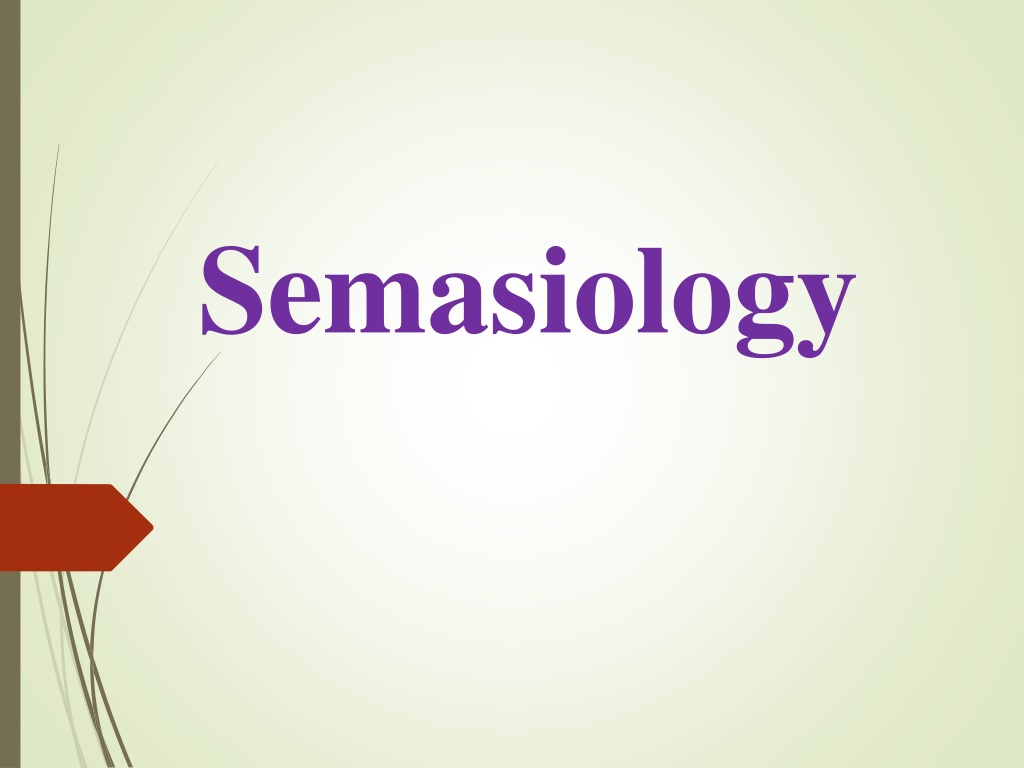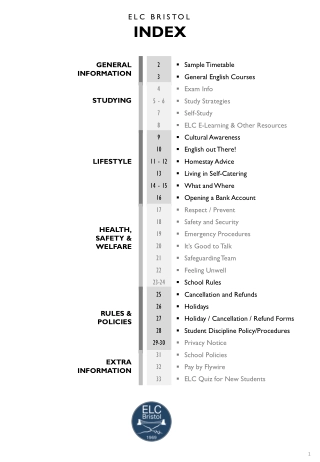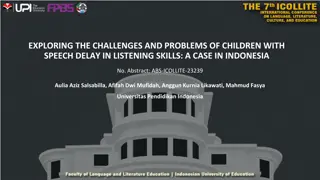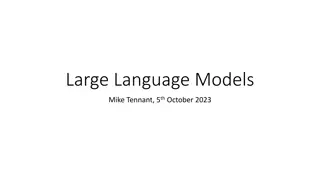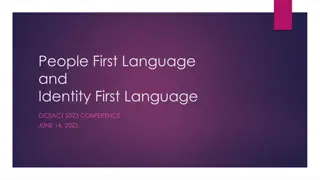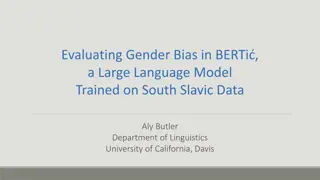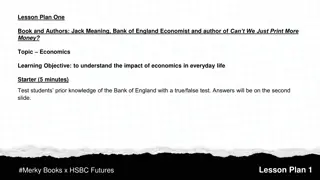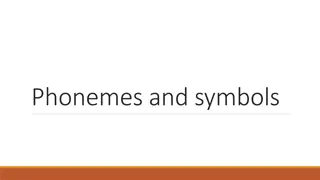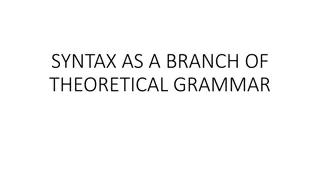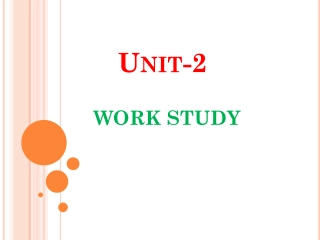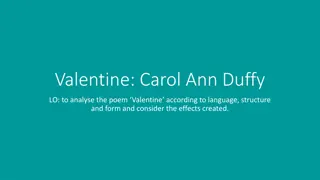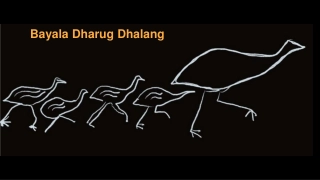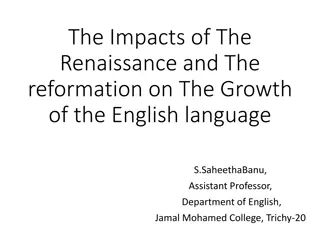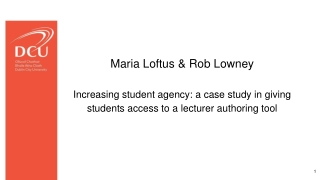Understanding Semasiology: The Study of Meaning in Language
Semasiology, a branch of lexicology, focuses on the study of meaning in language through different approaches such as the referent approach and functional approach. The referent approach links the sound form with the concept denoted by the word, while the functional approach emphasizes the relationship between linguistic units. Types of meaning include grammatical meaning and lexical meaning, with examples illustrating polysemy, where a word has multiple meanings. Explore the nuances of meaning in language through semasiology.
Download Presentation
Please find below an Image/Link to download the presentation.
The content on the website is provided AS IS for your information and personal use only. It may not be sold, licensed, or shared on other websites without obtaining consent from the author. Download presentation by click this link. If you encounter any issues during the download, it is possible that the publisher has removed the file from their server.
Presentation Transcript
Semasiology is a branch of lexicology, that is devoted to the study of meaning. There are different approaches to the study of meaning: 1. Referent approach 2. Functional approach
1. Referent approach. The concept The sound form referent The referential approach is a combination of 3 things: 1) The sound form is connected with our concept of the word which is denoted with the referent the actual word 2)The concept is a category of human cognition. The result of abstraction and generezation. 3) The meaning of the words are different in different languages. ( Ex: house a building for human habitation.)
2. Functional approach. The functional approach maintains that the meaning of a linguistic meaning may be started only through it s relation to other linguistic units. According to this approach the meanings of the words to move and movement are different, because this word function speech differently. Ex: to move can be followed noun (to move a chair) movement (movement of a car; slow movement) The same is true of the different meanings of one and the same word. Ex: to take (to take the book; to take the tram)
Types of meaning 1.Grammatical meaning. Grammatical meaning is defined as an expression in speech of relationship between words. -the meaning of plurality Ex: boys, girls, table -the tens meaning of the words Ex: asked, thought, worked
2. Lexical meaning. The word forms: go, gone, goes, going, gone posses different grammatical meanings. But we find one and the same semantic component the process of movement. This is a lexical meaning of the word.
Polysemy A word having several meanings is called polysemantic. Most English words are polysemantic and it s an advantage in a language, because the number of sound combination that human speech produce in limited. That s why polysemy becomes very important in providing the means for enriching vocabulary. Ex: the word fire: 1) a flame 2)An instance of destructive burning- a forest fire. 3) Burning material in a stove, fire-place - There is a fire in the next room. A camp fire. 4) The shooting of guns - to open (cease) fire. 5) Strong feeling, passion, enthusiasm - a speech lacking fire.
Ex: the word bar: 1)Any kind of barrier to prevent people from passing. 2) The profession of barrister, law e. g. go to the Bar read for the ar 3)A room where drinks are served; e. g. They went to the bar for a drink. 4) A peace of chocolate. Meanings 2,3,4 have no logical meaning with one another, but each of them can be associated with the first meaning.
Lets see example there is no central meaning. Ex: the word dull: 1) Uninteresting, monotonous, boring; e. g. a dull book, a dull film. 2) Slow in understanding, stupid; e. g. a dull student. 3) Not clear or bright; e. g. dull weather, a dull day, a dull colour. 4) Not loud or distinct; e. g. a dull sound. 5) Not sharp; e. g. a dull knife. 6) Not active; e. g. Trade is dull. 7) Seeing badly; e. g. dull eyes 8) Hearing badly; e. g. dull ears
Types of semantic component Denotative component is the living semantic meaning. The denotative component expresses the conceptual content of a word. Ex: lonely alone without company celebrated well know to glance to look to shiver to tremble
Connotative components give full picture of meaning. Ex: lonely - emotive connotation celebrated - evaluative connotation, positive to glare - Connotation of duration ; Emotive connotation to glance - Connotation of duration to shudder - Connotation of duration ; Emotive connotation Connotation of cause ;
Meaning and Context Context is a powerful possibility preventative against mist understanding of meaning. We can understand the meaning of the word only in combination with other words. Ex: adj. - dull Ex: adj. bright a dull book a) bright colour (flower) a dull pupil b) bright metal (gold, jewels) dull weather c)bright student (pupil, boy ) d) bright face (smile, eyes)
Causes of Development of New Meanings 1. The first group of causes is traditionally termed historical or extra- linguistic. All changes in society life, in culture, in knowledge lead the gaps in the vocabulary. Now object, new concepts must be named: 1)to make a new word 2) to borrowing foreign ones. Ex: When the first textile factories appeared in England, the old word mill was applied to these early industrial enterprises. mill textile factory Historical factors.
Ex: In the theater: The words stalls, box, pit, circle had existed for a long time before the first theatres appeared in England. New meanings can also be developed due to linguistic factors. In Russian language all words are borrows.
2. Linguistic factors. Linguistically speaking, the development of new meanings, and also a complete change of meaning, may be caused through the influence of other words. Ex: The Old English verb steorfan meant "to perish". The verb to die was borrowed from the Scandinavian. These two synonyms, which were very close in their meaning, collided, and, as a result, to starve gradually changed into its present meaning: "to die (or suffer) from hunger".
